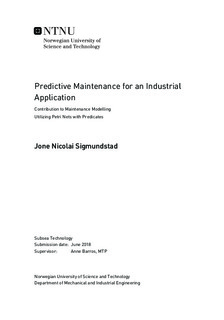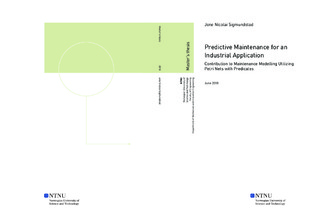| dc.description.abstract | In the current industrial scenario, maintenance activities are recognized as a strategic issue. With the increasing demands of the maintenance organizations, maintenance policies have to ensure that physical assets will continue to fulfill their intended function with a minimal expenditure of resources. This issue has led to a growing interest in new maintenance paradigms, such as Condition-Based Maintenance and Predictive Maintenance. These maintenance policies intend to operate systems in a dynamic way. Where failures are avoided through preventive actions, which are planned on-line, given the current and the predicted future condition of the system. This is a new paradigm that completely changes the problem statement for the operational decision rules.
This thesis aim was to investigate the aspects of Predictive Maintenance and maintenance modelling, in association with a study case provided by Equinor. With the objective to establish maintenance models of a gas compressor station, for analysis and optimizing of maintenance actions. Moreover, to highlight the possibilities and challenges within the field of Predictive Maintenance and maintenance modelling.
Maintenance modelling can be used for multiple objectives, within performance assessment and maintenance optimization. In general, the aim is to establish a model in which describes the behavior of the system, with associated organizational actions as maintenance policy. Further to implement the obtained optimal policy on the real-life system. In this study, Petri Nets with Predicates were utilized for modelling the system. The methods modelling capabilities make it suitable for modelling complex systems, where advanced maintenance policies are applied. The predicates allow implementation of conditional aspects needed to realize a realistic behavior of the model.
Two maintenance models were established for two different maintenance policies: Condition-Based Maintenance and Time-Based Maintenance. The models consisted of two compressor drive systems, for each system an electrical motor and compressor were included. For the Time-Based Maintenance model, a two-parameter Weibull distribution was utilized to model the failure characteristics of the respective components. Based on the mean time to failure, and different selected standard deviation, i.e. 10\%-, 20\%-, and 100\% of the mean time to failure. For the Condition-Based Maintenance model, a prognosis based degradation model from previous studies on the study case was applied on the electrical motor. In addition, a degradation model was established for the compressor.
The problem statement was to optimize maintenance actions to enhance system availability. Due to seasonal variations in the production demand, a reduced number of compressor drive systems is needed in certain time periods. Thus, it is possible to maintain the compressor drive system preventively in these periods, without causing downtime on the gas compressor station. Hence, the maintenance problem at hand is; "when should preventive maintenance actions be conducted, to make as little as possible impact on system availability?".
The maintenance model proposed where based on a variety of assumptions, simplifications, and limited data. A definite conclusion is therefore not given based on the results from the optimization and analysis of the maintenance models. Although, the results highlight interesting aspects of the system characteristics. It was recognized that the Condition-Based Maintenance policy achieves a high system availability, with a significant reduction in maintenance actions compared to the Time-Based Maintenance policy. Moreover, the standard deviation on the failure characteristics proved to have an insignificant impact on the performance of the policy, due to its dynamic nature. For low standard deviation, the Time-Based Maintenance policy achieves an even higher system availability. However, when increased the negative impact on the performance was substantial. Besides, the policy relayed on a large number of preventive maintenance actions, which is acknowledged as excessive.
The study highlights what is needed to build an adequate maintenance model. The model proposes a starting point for further work, where many aspects can be improved and implemented to enhance the accuracy of the model behavior. Through improvement, one can reach the case study's initial goal; a simulator that aids optimal maintenance decisions. | |

